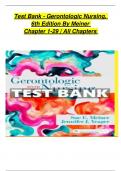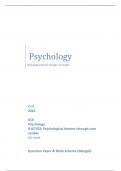Exam (elaborations)
Testbank for the Foundations of Maternal Newborn and Women's Health Nursing, 7th Edition By: Sharon Murray, Emily McKinney
- Course
- Institution
- Book
Testbank for the Foundations of Maternal Newborn and Women's Health Nursing, 7th Edition By: Sharon Murray, Emily McKinney Contents PART I: FOUNDATIONS FOR NURSING CARE OF THE CHILDBEARING FAMILIES 1. Maternity and Women’s Health Care Today 2. Social, Ethical and Legal Issues 3. Reprodu...
[Show more]












